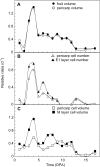Cell layer-specific patterns of cell division and cell expansion during fruit set and fruit growth in tomato pericarp
- PMID: 28369617
- PMCID: PMC5444452
- DOI: 10.1093/jxb/erx058
Cell layer-specific patterns of cell division and cell expansion during fruit set and fruit growth in tomato pericarp
Abstract
In angiosperms, the ovary wall resumes growth after pollination through a balanced combination of cell division and cell expansion. The quantitative pattern of these events remains poorly known in fleshy fruits such as tomato (Solanum spp.), in which dramatic growth of the pericarp occurs together with endoreduplication. Here, this pattern is reported at the level of each of the cell layers or groups of cell layers composing the pericarp, except for vascular bundles. Overall, cell division and cell expansion occurred at similar rates for 9 days post anthesis (DPA), with very specific patterns according to the layers. Subsequently, only cell expansion continued for up to 3-4 more weeks. New cell layers in the pericarp originated from periclinal cell divisions in the two sub-epidermal cell layers. The shortest doubling times for cell number and for cell volume were both detected early, at 4 DPA, in epicarp and mesocarp respectively, and were both found to be close to 14 h. Endoreduplication started before anthesis in pericarp and was stimulated at fruit set. It is proposed that cell division, endoreduplication, and cell expansion are triggered simultaneously in specific cell layers by the same signals issuing from pollination and fertilization, which contribute to the fastest relative fruit growth early after fruit set.
Keywords: Cell division; Solanum lycopersicum; cell expansion; endoreduplication; fruit; fruit set; growth rate; pericarp; tomato..
© The Author 2017. Published by Oxford University Press on behalf of the Society for Experimental Biology.
Figures







References
-
- Barow M. 2006. Endopolyploidy in seed plants. Bioessays 28, 271–281. - PubMed
-
- Bergervoet J, Verhoeven H, Gilissen LJW, Bino R. 1996. High amounts of nuclear DNA in tomato (Lycopersicon esculentum Mill.) pericarp. Plant Science 116, 141–145.
MeSH terms
LinkOut - more resources
Full Text Sources
Other Literature Sources
Miscellaneous

